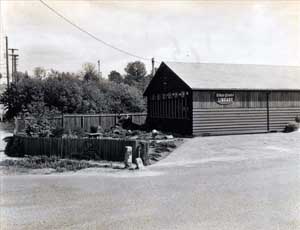On April 18, 1961, the White Center Library holds dedication ceremonies for its new building at 1205 SW 102nd Street. The opening completes a swap of unusual quarters, from a fieldhouse basement to the library's first home of its own, a wood-framed former school gymnasium transported from Seattle. The relocated building has been substantially transformed, with much of the work done by volunteers, into a modern, spacious, well-lighted library.
Subterranean Blues
The White Center Library had operated in a small room under the front porch of the White Center Fieldhouse since July 23, 1946, the same year it joined the King County Library System. The space was long and narrow (10.5 feet by 49 feet), dark, and noisy. The White Center News later described it as a "catacomb" and "the antithesis of anybody's idea of a library. Patrons would turn their pages accompanied by the thumping rhythms of basketballs and running feet" ("Library Classic Example ..."). The paper also noted that the library was "insignificantly located in a basement cubbyhole" ("White Center Library ..."), and "hidden in the depths of the White Center Fieldhouse" ("W.C. Library Buys Building ...").
The White Center Library Guild formed in 1952 and worked to improve conditions. The Guild raised money to build shelves and improve lighting. It also installed a separate entrance in 1955. The library previously shared an entrance with a women's restroom. As recalled by longtime librarian Gertrude Finney (1910-2011), having a sign over the door that said "Women" tended to discourage male patrons.
As the community grew, so did circulation at the library. Increased use underscored the need for a bigger space. Starting in 1956, library fees were diverted from making improvements to a fund for a new building, and the White Center Commercial Club and Library Guild members began looking for a suitable structure.
Transforming a Gym
They found the building they needed north of downtown Seattle, in the Lower Queen Anne neighborhood. The former Warren Avenue School gymnasium, the kind of annex typically described as a portable, had to make way for the Century 21 Exposition and was for sale. White Center's library hunters bought it in 1959, put it on wheels, and moved it to leased space on the northeast corner of the fieldhouse grounds.
The building cost $4,900. The price of renovation -- actually a redesign and extensive makeover -- was an estimated $7,500. A building drive, which included tea and Tupperware parties, used book sales, and other fundraising events along with donations from businesses and individuals, raised more than $10,000 by April 1961. That, combined with the Guild's savings of nearly $4,000, covered most of the project.
What had been a plain 30-by-70-foot portable building was significantly transformed, with much of the work done by volunteers. The boxy structure gained a porch entryway with glass doors and a sloped roof. What had been a few small windows were replaced on the street side with a wide bank of tall panes looking out at fenced-in landscaping. The building's exterior was painted dark brown with coral trim. The interior was paneled and brightly lit. It had hardwood floors, new chairs and tables, newly built shelves, restrooms, and a small kitchen. It was about four times as big as the subterranean space it replaced.
Beautiful, Modern, and Spacious
The White Center Library's first building of its own was dedicated on April 18, 1961. The White Center News, which had crusaded for a new library, hailed the structure as "beautiful, modern, well-lighted and spacious," and, in saluting the many community groups and individuals involved, concluded, "The pioneer spirit is obviously not yet dead -- at least not in Greater White Center" ("Library Classic Example ...").
The beautifully remodeled former gym served as White Center's library for 15 years. In 1975, the White Center Library moved into a new building constructed specifically for it at a cost of $300,000, funded by a library bond issue approved by county voters in 1966. That building served the community for four decades, until May 2016, when the current White Center Library opened. The $8.5 million, 10,000-square-foot building was also funded by a county bond measure, a $172 million bond issue approved by voters in 2004.

